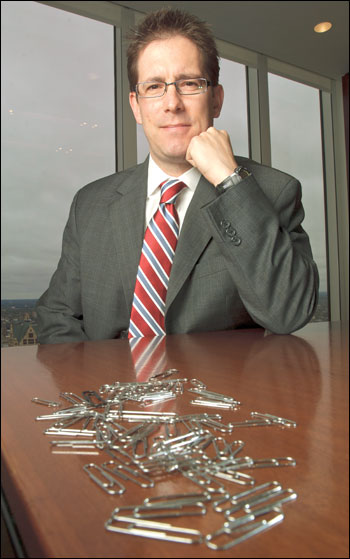New technology could streamline e-discovery process
By: Jane Pribek//October 31, 2011//

Attorney Eric Maassen plans to use a lot less paper clips and Post-its in the near future.
The page markers used to play a large role in distinguishing relevant information found in documents during case discovery, he said. But with the rise of e-discovery and new technology that requires less people poring over documents, Maassen, a partner at Foley & Lardner LLP, Milwaukee, soon might be able to give his eyes and office supplies a rest.
“The technology for users to create and store documents (electronically) has just exploded in the past few years,” he said.
The rise of electronic documents over hard copies means less physical reading of materials and more scanning on screen, or e-discovery. That review process could get even easier, and possibly more accurate, because of the rise of predictive coding software that allows lawyers to specify small sets of data that define the heart of the dispute, and specifically search electronic documents for related information.
Predictive coding’s digital algorithms work so computers learn to distinguish what information is most relevant to a particular case.
The new technology is an improvement, Maassen said, over existing software that can group information by subject, weed out duplicate information and categorize materials, but still is reliant on human time and judgment.
It also might be more accurate than human reviewers, who miss between 20 percent and 75 percent of all relevant documents, according to a recent study in the Richmond Journal of Law and Technology.

Timothy Edwards, a partner with Axley Brynelson LLP, Madison, said he didn’t doubt the veracity of those findings.
“It doesn’t surprise me, because when lawyers conduct a review, they’d never want to admit it, but they’re scanning through these documents; they’re not reading them word-for-word,” he said. “And they can miss things as a result. You can imagine sitting down six or seven hours a day, poring through documents.”

Predictive coding is the “new toy” for attorneys, said attorney Wendy Akbar, a Phoenix attorney employed by Milwaukee-based Quarles & Brady LLP.
“Everyone wants to play with it,” she said. “Theoretically, used correctly, predictive coding should eliminate much of the traditional review process.”
It might take some time before the new technology catches on with clients, however, Akbar said.
“No longer can a client rest easy knowing that a team of attorneys he has personally met is reviewing and coding his documents,” she said.
Risk-averse clients might have a hard time learning to trust the computer’s methods, she said.
“The idea of trusting some unknown method of artificial intelligence in what may well be a $50 million case makes clients understandably reluctant,” Akbar said.
Akbar has tried the technology, though, she said, and saw successful results.
Maassen said Foley & Lardner’s e-discovery team is pitching a client on using predictive coding in an upcoming case, in part because they expected it would save the client money.
Edwards said he had not used it, but expected that would change soon.
“Ultimately, I suspect it will be the result of a process,” he said, “where the lawyers meet and confer, hopefully in good faith, and identify this as the most productive and efficient way to get the information.”
Depending on the amount of data that needs to be looked over for a case, Edwards said, he’d feel comfortable recommending predictive coding to clients. But the technology still will require some oversight, he said.
“It’s only going to be as effective as the skill level of the people employing the product,” he said. “In the wrong hands, or if someone wants to play games with it, it can be used for questionable purposes.”
There’s also some concern about the technology’s potential for inadvertent disclosures of material that otherwise is protected by attorney-client privilege, he said. Federal rule of Evidence 502 holds that it’s not a waiver when the privilege holder took “reasonable steps” to prevent disclosure.
“If you’re just running searches through a big stack of documents, kicking out a bunch of information and the other side sees it, you’ve let the cat out of the bag,” Edwards said. “Courts are going to have to deal with that.”
At some point soon, Maassen said, likely there will be court decisions that find predictive coding is an acceptable alternative to human review.
The technology’s cost and the time it takes to learn how to use it and apply it could keep some firms from trying it, Akbar said, but it could be a way for litigation boutiques to distinguish themselves from their comparatively-sized peers.
“Once some firms go down this path, the others will eventually follow as well,” she said. “In the end, predictive coding, or similar technology, may become the rule rather than the exception.”
Legal News
- State Bar leaders remain deeply divided over special purpose trust
- Former Wisconsin college chancellor fired over porn career is fighting to keep his faculty post
- Pecker says he pledged to be Trump campaign’s ‘eyes and ears’ during 2016 race
- A conservative quest to limit diversity programs gains momentum in states
- Wisconsin prison inmate pleads not guilty to killing cellmate
- Waukesha man sentenced to 30 years for Sex Trafficking
- 12-year-old shot in Milwaukee Wednesday with ‘serious injuries’
- Milwaukee man convicted of laundering proceeds of business email compromise fraud schemes
- Giuliani, Meadows among 18 indicted in Arizona fake electors case
- Some State Bar diversity participants walk away from program
- Wisconsin court issues arrest warrant ‘in error’ for Minocqua Brewing owner
- Iranian nationals charged cyber campaign targeting U.S. Companies
WLJ People
- Power 30 Personal Injury Attorneys – Russell Nicolet
- Power 30 Personal Injury Attorneys – Benjamin Nicolet
- Power 30 Personal Injury Attorneys – Dustin T. Woehl
- Power 30 Personal Injury Attorneys – Katherine Metzger
- Power 30 Personal Injury Attorneys – Joseph Ryan
- Power 30 Personal Injury Attorneys – James M. Ryan
- Power 30 Personal Injury Attorneys – Dana Wachs
- Power 30 Personal Injury Attorneys – Mark L. Thomsen
- Power 30 Personal Injury Attorneys – Matthew Lein
- Power 30 Personal Injury Attorneys – Jeffrey A. Pitman
- Power 30 Personal Injury Attorneys – William Pemberton
- Power 30 Personal Injury Attorneys – Howard S. Sicula






